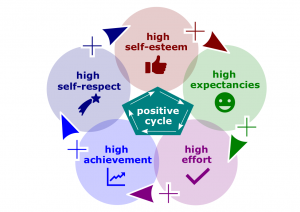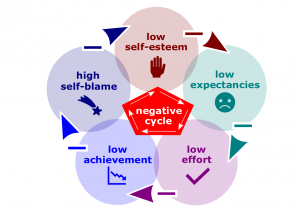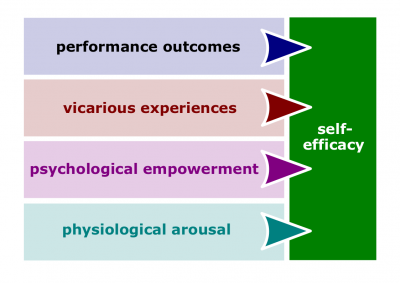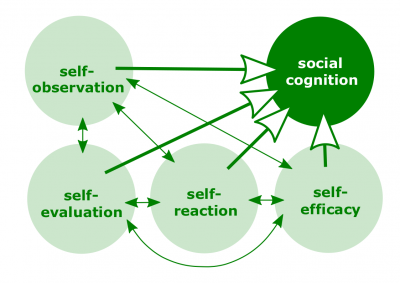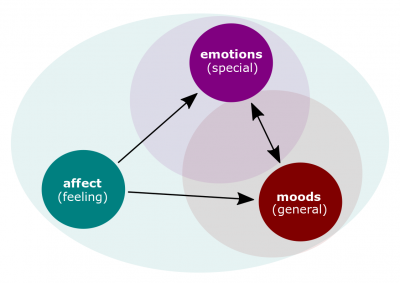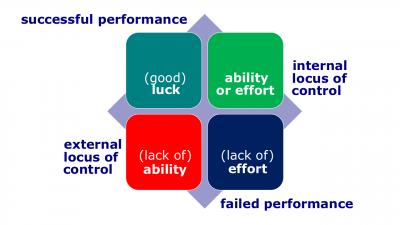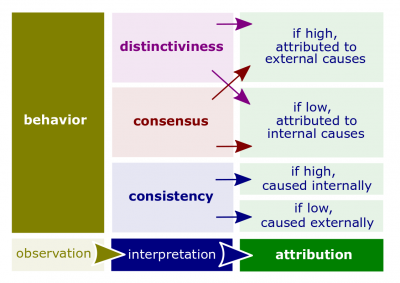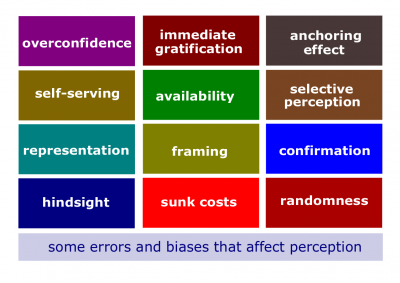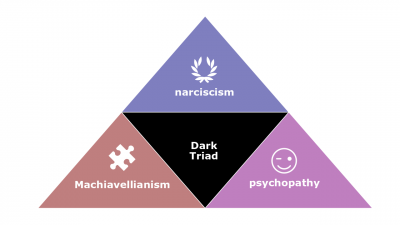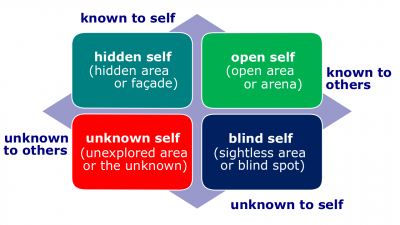Difference between revisions of "Human Perceptions Quarter"
(→Concepts) |
|||
| (81 intermediate revisions by 2 users not shown) | |||
| Line 1: | Line 1: | ||
| − | [[Human Perceptions Quarter]] (hereinafter, the ''Quarter'') is the | + | [[Human Perceptions Quarter]] (hereinafter, the ''Quarter'') is a lecture introducing the learners to [[individuals discovery]] primarily through key topics related to [[perception]]. The ''Quarter'' is the first of four lectures of [[Individuals Quadrivium]], which is the fourth of seven modules of '''[[Septem Artes Administrativi]]''' (hereinafter, the ''Course''). The ''Course'' is designed to introduce the learners to general concepts in [[business administration]], [[management]], and [[organizational behavior]]. |
| − | |||
| − | |||
| − | |||
| − | |||
==Outline== | ==Outline== | ||
| − | '' | + | ''[[Operations Management Quarter]] is the predecessor lecture. In the [[enterprise discovery]] series, the previous lecture is [[Monitoring Quarter]].'' |
| + | :[[Individuals discovery]] is data discovery conducted by [[human being]]s. This [[data]] is either stored in [[brain]]s or sensed from [[external environment]]s. This particular lecture concentrates on [[human perceptions]] because this method is instrumental for collecting [[data]] that routinely emerges. | ||
===Concepts=== | ===Concepts=== | ||
#'''[[Perception]]'''. A process by which individuals organize and interpret their sensory impressions in order to give meaning to their environment. | #'''[[Perception]]'''. A process by which individuals organize and interpret their sensory impressions in order to give meaning to their environment. | ||
| − | |||
#*[[Psychology]]. The science that seeks to measure, explain, and sometimes change the behavior of humans and other animals. | #*[[Psychology]]. The science that seeks to measure, explain, and sometimes change the behavior of humans and other animals. | ||
| − | #'''[[Cognitive | + | #*[[Sense]]. (1) A faculty by which the body perceives an external stimulus; one of the faculties of sight, smell, hearing, taste, and touch; (2) A feeling that something is the case. |
| − | #*[[Physical ability]]. An individual's capacity to do tasks that demand stamina, dexterity, strength, and similar characteristics. | + | #*[[Social-learning theory]]. The view that we can learn through both [[observation]] and direct experience. |
| + | #'''[[Cognitive capability]]'''. Power or ability to perceive and understand [[external environment]] and its [[process]]es. | ||
| + | #*[[Physical ability]]. An individual's [[capacity]] to do tasks that demand stamina, dexterity, strength, and similar characteristics. | ||
#*[[Heredity]]. Factors determined at conception; one's biological, physiological, and inherent psychological makeup. | #*[[Heredity]]. Factors determined at conception; one's biological, physiological, and inherent psychological makeup. | ||
| − | #*[[Intellectual ability]]. An individual's capacity to do mental activities -- thinking, reasoning, and problem solving. | + | #*[[Intellectual ability]]. An individual's [[capacity]] to do mental activities -- thinking, reasoning, and problem solving constrained by human limitations particularly expressed by the [[Allegory of the Cave]]. |
| − | #*[[Information overload]]. A condition in which information inflow exceeds an individual's processing capacity. | + | #*[[Information overload]]. A condition in which information inflow exceeds an individual's processing [[capacity]]. |
| − | #*[[ | + | #'''[[Self-concept]]'''. An idea of the self constructed from the beliefs one holds about oneself and the responses of others. |
| − | #'''[[Affect]]'''. A broad range of feelings that people experience. | + | #*[[Self-esteem]]. (1) Confidence in one's own worth or abilities; (2) Self-respect; (3) An individual's degree of like or dislike for herself or himself.<blockquote><table class="wikitable" width=100% style="text-align:center;"><tr><td>[[Self-esteem|Self‑esteem]]</td><th>[[High self-esteem|High self‑esteem]]</th><th>[[Low self-esteem|Low self‑esteem]]</th></tr><tr><th>Cycle</th><td>[[File:High-self-esteem.png|300px|center]]</td><td>[[File:Low-self-esteem.png|300px|center]]</td></tr></table></blockquote> |
| + | #*[[Self-efficacy]]. (1) An individual's belief that she or he is capable of performing a task; (2) An individual's belief in the likelihood of goal completion that can be motivating in itself; (3) A development process of one's belief in the likelihood of goal completion. | ||
| + | #[[File:Self-efficacy-sources.png|400px|thumb|right|[[Self-efficacy source]]s]]'''[[Self-efficacy source]]'''. A [[source]] for [[self-efficacy]]. Those ''sources'' are also objects of the [[self-efficacy theory]], initially developed by [[Albert Bandura]]. | ||
| + | #*[[Performance outcome]]. Positive and/or negative experiences are the primary sources for [[self-efficacy]]. They influence the ability of an individual to perform a given task.<blockquote> If one has performed well at a task previously, they are more likely to feel competent and perform well at a related task. [...] Vice versa, previously failed tasks will result in low self-efficacy (Redmond, 2010).</blockquote>Similarly, achieving simple tasks leads to more complex objectives. | ||
| + | #*[[Vicarious experience]] (also known as [[vicarious modeling]] or [[social modeling]]). ). An identifiable model that shows the processes that accomplish a behavior. People can develop [[high self-efficacy|high]] or [[low self-efficacy]] vicariously through other people's performances.<blockquote>A person can watch another perform and then compare their competence with the other's competence (Redmond, 2010).</blockquote>If a person sees someone similar to them succeed, it can increase their self-efficacy. However, the opposite is also true; seeing someone similar fail can lower self-efficacy. An example of how vicarious experiences can increase self-efficacy in the work place is through mentoring programs, where an individual can be paired with someone on a similar career path who is successful at raising the individual’s self-efficacy beliefs. An example of how the opposite can be true is in a smoking cessation program where if one or two people fail to quit, another person's efficacy belief can be lowered, hence he/she may also fail to quit. | ||
| + | #*[[Psychological empowerment]]. Elevation of one's belief in the degree to which he or she affects his or her environment, the competence, the meaningfulness of one's functions, and their perceived autonomy in their activities. | ||
| + | #*[[Physiological arousal]]. Improving physical and emotional states that refer to ensuring that an individual experiences sensations from his or her body since emotional arousals may influence his or her beliefs of efficacy.<blockquote>Some examples of physiological feedback are: giving a speech in front of a large group of people, making a presentation to an important client, taking an exam, etc. All of these tasks can cause agitation, anxiety, sweaty palms, and/or a racing heart. (Redmond, 2010)</blockquote>Although this source is the least influential of the four, it is important to note that if one is more at ease with the task at hand they will feel more capable and have higher beliefs of [[self-efficacy]]. | ||
| + | #[[File:Social-cognitive.png|400px|thumb|right|[[Social cognitive theory]]]]'''[[Social cognitive theory]]'''. A theory used in [[psychology]], [[education]], and [[communication]] that suggests that portions of an individual's knowledge acquisition can be directly related to observing others within the context of social interactions, experiences, and outside media influences. According to this ''theory'', social cognition is composed of four processes of goal realization: [[self-observation]], [[self-evaluation]], [[self-reaction]], and [[self-efficacy]]. These components are interrelated and each have an effect on motivation and goal attainment. | ||
| + | #*[[Self-observation]]. - Observing oneself can inform and motivate. It can be used to assess one’s progress towards goal attainment as well as motivate behavioral changes. There are two important factors with regards to self observation; regularity and proximity. Regularity means the behavior should be continually observed whereas proximity means the behavior should be observed while it occurs, or shortly after. Alone, self observation is insufficient because motivation depends on one’s expectations of outcomes and efficacy (Zimmerman & Schunk, 2001). | ||
| + | #*[[Self-evaluation]] - Comparing one's current performance with a desired performance or goal. Self evaluation is affected by the standards set and the importance of the goals. Goals must be specific and important; therefore, goals such as, "do your best" are vague and will not motivate. If one has little regard for their goal they will not evaluate performance. There are two types of self-evaluation standards: absolute and normative. For example, a grading scale would be an example of a fixed or absolute standard. A social comparison such as evaluating one’s behavior or performance against other individuals is an example of a normative standard (Zimmerman & Schunk, 2001). People gain satisfaction when they achieve goals that they value. When individuals achieve these goals, they are more likely to continue to make every effort since sub-standard performance will no longer provide satisfaction (Bandura, 1989). | ||
| + | #*[[Self-reaction]] - Reactions to one’s performance can be motivating. If progress is deemed acceptable, then one will have a feeling of self-efficacy with regards to continuing, and will be motivated towards the achievement of their goal. A negative self evaluation may also be motivating in that one may desire to work harder providing that they consider the goal as valuable. Self reaction also allows a person to re-evaluate their goals in conjunction with their attainments (Bandura, 1989). If a person has achieved a goal, they are likely to re-evaluate and raise the standard (goal); whereas, if a person has not achieved the goal they are likely to re-evaluate and lower the standard (goal) to an achievable goal. | ||
| + | #[[File:Emotions-vs-moods.png|400px|thumb|right|[[Affect]]]]'''[[Affect]]'''. A broad range of feelings that people experience. | ||
#*[[Positive affect]]. A mood dimension that consists of specific positive emotions such as excitement, enthusiasm, and elation at the high end. | #*[[Positive affect]]. A mood dimension that consists of specific positive emotions such as excitement, enthusiasm, and elation at the high end. | ||
#*[[Negative affect]]. A mood dimension that consists of specific negative emotions such as nervousness, stress, and anxiety at the high end. | #*[[Negative affect]]. A mood dimension that consists of specific negative emotions such as nervousness, stress, and anxiety at the high end. | ||
| Line 26: | Line 35: | ||
#*[[Positivity offset]]. The tendency of most individuals to experience a mildly positive mood at zero input (when nothing in particular is going on). | #*[[Positivity offset]]. The tendency of most individuals to experience a mildly positive mood at zero input (when nothing in particular is going on). | ||
#'''[[Emotion]]'''. Intense feeling that is directed at someone or something. | #'''[[Emotion]]'''. Intense feeling that is directed at someone or something. | ||
| − | |||
#*[[Felt emotion]]. An individual's actual emotions. | #*[[Felt emotion]]. An individual's actual emotions. | ||
#*[[Displayed emotion]]. An [[emotion]] that is organizationally required and considered appropriate in a given job. | #*[[Displayed emotion]]. An [[emotion]] that is organizationally required and considered appropriate in a given job. | ||
#*[[Moral emotion]]. An [[emotion]] that have moral implications. | #*[[Moral emotion]]. An [[emotion]] that have moral implications. | ||
| − | + | #'''[[Attribution theory]]'''. A theory used to explain how we judge people differently depending on what meaning we attribute to a given behavior. This ''theory'' also attempts to determine whether an individual's behavior is internally or externally caused.<blockquote><table class="wikitable" width=100% style="text-align:center;"><tr><td>[[Attribution factor|Factor]]s</td><th>[[Observation]]</th><th>[[Interpretation]]</th><th>[[Attribution]]</th></tr><tr><th rowspan="2">[[Distinctiveness factor|Distinctiveness]]</th><td>The individual behaves this way in other situations</td><td>Low distinctiveness</td><td>[[Dispositional attribution|Internal]]</td></tr><tr><td>The individual behaves differently in other situations</td><td>High distinctiveness</td><td>[[Situational attribution|External]]</td></tr><tr><th rowspan="2">[[Consensus factor|Consensus]]</th><td>Other people behave the same way in similar situations</td><td>High consensus</td><td>[[Situational attribution|External]]</td></tr><tr><td>Other people behave differently in similar situations</td><td>Low consensus</td><td>[[Dispositional attribution|Internal]]</td></tr><tr><th rowspan="2">[[Consistency factor|Consistency]]</th><td>The individual behaves this way consistently</td><td>High consistency</td><td>[[Dispositional attribution|Internal]]</td></tr><tr><td>The individual behaves this way rarely</td><td>Low consistency</td><td>[[Situational attribution|External]]</td></tr></table></blockquote>[[File:Attribution-theory.png|400px|thumb|right|[[Attribution theory]]]] | |
| − | #'''[[Attribution theory]]'''. A theory used to explain how we judge people differently depending on what meaning we attribute to a given behavior. | ||
| − | |||
| − | |||
#*[[Fundamental attribution error]]. The tendency to underestimate the influence of external factors and overestimate the influence of internal factors when making judgments about the behavior of others. | #*[[Fundamental attribution error]]. The tendency to underestimate the influence of external factors and overestimate the influence of internal factors when making judgments about the behavior of others. | ||
| − | |||
| − | |||
#*[[Self-serving bias]]. The tendency for individuals to attribute their own successes to internal factors while putting the blame for failures on external factors. | #*[[Self-serving bias]]. The tendency for individuals to attribute their own successes to internal factors while putting the blame for failures on external factors. | ||
| − | #*[[ | + | #[[File:Attribution-factors.png|400px|thumb|right|[[Attribution factor]]]]'''[[Attribution factor]]'''. One of three factors that determine attribution of observed behavior to external or internal causes under the [[attribution theory]]. |
| − | #'''[[ | + | #*[[Distinctiveness factor]]. |
| + | #*[[Consistency factor]]. | ||
| + | #*[[Consensus factor]]. | ||
| + | #'''[[Locus of control]]'''. A personality attribute that measures the degree to which people believe they control their own fate. | ||
| + | #*[[Situational attribution]] ([[external attribution]]). | ||
| + | #*[[Dispositional attribution]] ([[internal attribution]]). | ||
| + | #'''[[Reaffirmation tendency]]'''. An inclination toward favorable perception of something that reaffirms one's [[attitude]]s. | ||
#*[[Confirmation bias]]. The tendency to seek out information that reaffirms past choices and to discount information that contradicts past judgments. | #*[[Confirmation bias]]. The tendency to seek out information that reaffirms past choices and to discount information that contradicts past judgments. | ||
| + | #*[[Selective perception]]. The tendency to selectively interpret what one sees on the basis of one's interests, background, experience, and [[attitude]]s. | ||
| + | #*[[Self-fulfilling prophecy]]. A situation in which a person inaccurately perceives a second person, and the resulting expectations cause the second person to behave in ways consistent with the original perception. | ||
| + | #[[File:Biases.png|400px|thumb|right|[[Perception shortcut]]]]'''[[Perception shortcut]]'''. A shorter alternative route in cognitive processing. | ||
| + | #*[[Bias]]. A tendency or preference toward a particular perspective or ideology. | ||
#*[[Hindsight bias]]. The tendency to believe falsely, after an outcome of an event is actually known, that one would have accurately predicted that outcome. | #*[[Hindsight bias]]. The tendency to believe falsely, after an outcome of an event is actually known, that one would have accurately predicted that outcome. | ||
#*[[Anchoring bias]]. A tendency to fixate on initial information, from which one then falls to adequately adjust for subsequent information. | #*[[Anchoring bias]]. A tendency to fixate on initial information, from which one then falls to adequately adjust for subsequent information. | ||
#*[[Availability bias]]. The tendency for people to base their judgments on information that is readily available to them. | #*[[Availability bias]]. The tendency for people to base their judgments on information that is readily available to them. | ||
| − | |||
#*[[Assumed similarity]]. The assumption that others are like oneself. | #*[[Assumed similarity]]. The assumption that others are like oneself. | ||
#*[[Randomness error]]. The tendency of individuals to believe that they can predict the outcomes of random events. | #*[[Randomness error]]. The tendency of individuals to believe that they can predict the outcomes of random events. | ||
| − | |||
#*[[Halo effect]]. The tendency to draw a general impression about an individual on the basis of a single characteristic. | #*[[Halo effect]]. The tendency to draw a general impression about an individual on the basis of a single characteristic. | ||
#*[[Contrast effect]]. Evaluation of a person's characteristics that is affected by comparisons with other people recently encountered who rank higher or lower on the same characteristics. | #*[[Contrast effect]]. Evaluation of a person's characteristics that is affected by comparisons with other people recently encountered who rank higher or lower on the same characteristics. | ||
#*[[Illusory correlation]]. The tendency of people to associate two events when in reality there is no connection. | #*[[Illusory correlation]]. The tendency of people to associate two events when in reality there is no connection. | ||
| − | + | #'''[[Personality]]'''. The unique combination of emotional, thought, and behavioral patterns that affect how a person reacts to situations and interacts with others. | |
| − | #'''[[Personality]]''' | ||
| − | |||
| − | |||
#*[[Emotional stability]]. A personality dimension that characterizes someone as calm, self-confident, and secure (positive) versus nervous, depressed, and insecure (negative). | #*[[Emotional stability]]. A personality dimension that characterizes someone as calm, self-confident, and secure (positive) versus nervous, depressed, and insecure (negative). | ||
#*[[Openness to experience]]. A personality dimension that characterizes someone in terms of imagination, sensitivity, and curiosity. | #*[[Openness to experience]]. A personality dimension that characterizes someone in terms of imagination, sensitivity, and curiosity. | ||
| Line 61: | Line 69: | ||
#*[[Conscientiousness]]. A personality dimension that describes someone who is responsible, dependable, persistent, and organized. | #*[[Conscientiousness]]. A personality dimension that describes someone who is responsible, dependable, persistent, and organized. | ||
#*[[Extraversion]]. A personality dimension describing someone who is sociable, gregarious, and assertive. | #*[[Extraversion]]. A personality dimension describing someone who is sociable, gregarious, and assertive. | ||
| − | #'''[[Dark Triad]]'''. A constellation of negative personality traits consisting of [[Machiavellianism]], [[narcissism]], and [[psychopathy]]. | + | #*[[Intraversion]]. The opposite of [[extraversion]]. |
| + | #[[File:Dark-triad.png|400px|thumb|right|[[Dark Triad]]]]'''[[Dark Triad]]'''. A constellation of negative personality traits consisting of [[Machiavellianism]], [[narcissism]], and [[psychopathy]]. | ||
#*[[Narcissism]]. The tendency to be arrogant, have a grandiose sense of self-importance, require excessive admiration, and have a sense of entitlement. | #*[[Narcissism]]. The tendency to be arrogant, have a grandiose sense of self-importance, require excessive admiration, and have a sense of entitlement. | ||
#*[[Psychopathy]]. The tendency for a lack of concern for others and lack of guilt or remorse when actions cause harm. | #*[[Psychopathy]]. The tendency for a lack of concern for others and lack of guilt or remorse when actions cause harm. | ||
| − | |||
#*[[Machiavellianism]]. The degree to which an individual is pragmatic, maintains emotional distance, and believes that ends can justify means. | #*[[Machiavellianism]]. The degree to which an individual is pragmatic, maintains emotional distance, and believes that ends can justify means. | ||
#'''[[Personality trait]]'''. An enduring characteristic that describes an individual's behavior. | #'''[[Personality trait]]'''. An enduring characteristic that describes an individual's behavior. | ||
| − | #*[[Proactive personality]]. A personality trait that describes individuals who are more prone to take actions to influence their environments. | + | #*[[Proactive personality]]. A personality trait that describes individuals who are more prone to take actions to influence their environments. These individuals identify opportunities, show initiative, and persevere until meaningful change occurs. |
| − | |||
| − | |||
#*[[Self-monitoring]]. A personality trait that measures an individual's ability to adjust his or her behavior to external, situational factors. | #*[[Self-monitoring]]. A personality trait that measures an individual's ability to adjust his or her behavior to external, situational factors. | ||
#*[[Type A personality]]. People who have a chronic sense of urgency and an excessive competitive drive. | #*[[Type A personality]]. People who have a chronic sense of urgency and an excessive competitive drive. | ||
#*[[Type B personality]]. People who are relaxed and easygoing and accept change easily. | #*[[Type B personality]]. People who are relaxed and easygoing and accept change easily. | ||
| − | |||
| − | |||
| − | |||
| − | |||
#'''[[Trait activation theory]]'''. A theory that predicts that some situations, events, or interventions "activate" a trait more than others. | #'''[[Trait activation theory]]'''. A theory that predicts that some situations, events, or interventions "activate" a trait more than others. | ||
#*[[Situation strength theory]]. A theory indicating that the way personality translates into behavior depends on the strength of the situation. | #*[[Situation strength theory]]. A theory indicating that the way personality translates into behavior depends on the strength of the situation. | ||
| − | #'''[[Core value]]''' (collectively, also known as [[values]]). A basic conviction that a specific mode of conduct or end-state of existence is personally or socially preferable to an opposite or converse mode of conduct or end-state of existence. | + | #'''[[Core value]]''' (collectively, also known as [[Core value|values]]). A basic conviction that a specific mode of conduct or end-state of existence is personally or socially preferable to an opposite or converse mode of conduct or end-state of existence. In other words, [[Core value|values]] are basic convictions about what is right and wrong. |
| − | |||
#*[[Instrumental value]]. A preferable mode of behavior or mean of achieving one's [[terminal value]]s. | #*[[Instrumental value]]. A preferable mode of behavior or mean of achieving one's [[terminal value]]s. | ||
#*[[Terminal value]]. A desirable end-state of existence; the goal a person would like to achieve during his or her lifetime. | #*[[Terminal value]]. A desirable end-state of existence; the goal a person would like to achieve during his or her lifetime. | ||
#*[[Values system]]. A hierarchy based on a ranking of an individual's values in terms of their intensity. | #*[[Values system]]. A hierarchy based on a ranking of an individual's values in terms of their intensity. | ||
#*[[Self-concordance]]. The degree to which people's reasons for pursuing goals are consistent with their interests and [[core value]]s. | #*[[Self-concordance]]. The degree to which people's reasons for pursuing goals are consistent with their interests and [[core value]]s. | ||
| + | |||
| + | ===Roles=== | ||
| + | #'''[[Counseling psychologist]]'''. A professional who assesses and evaluates individuals' problems through the use of case history, interview, and observation and provides individual or group counseling services to assist individuals or employers in achieving more effective personal, social, educational, and vocational development and adjustment. | ||
===Methods=== | ===Methods=== | ||
| + | #'''[[Divided line]]'''. A method of cognitive classification based on the [[analogy of the divided line]]. | ||
| + | |||
===Instruments=== | ===Instruments=== | ||
| + | #[[File:Johari.png|400px|thumb|right|[[Johari Window]]]]'''[[Johari Window]]'''. A tool used to illustrate and improve self-awareness, and mutual understanding between individuals within a group. [[Johari Window]] can also be used to assess and improve a group's relationship with other groups. | ||
| + | #'''[[Big Five Model]]'''. A personality trait model that includes [[extraversion]], [[agreeableness]], [[conscientiousness]], [[emotional stability]], and [[openness to experience]]. | ||
| + | #'''[[Myers-Briggs Type Indicator]]''' ([[Myers-Briggs Type Indicator|MBTI]]). A personality test that taps four characteristics and classifies people into one of 16 personality types. Every characteristic contributes one letter from the following pairs: [[Extraversion]] ('''E''') or [[Intraversion]] ('''I''') depending on onward or inward focus, [[Sensing]] ('''S''') or [[Intuition]] ('''N''') depending on preference in taking in information, [[Thinking]] ('''T''') or [[Feeling]] ('''F''') depending on preference in making decisions, [[Judging]] ('''J''') or [[Perceiving]] ('''P''') depending on preference in living outer life. | ||
| + | |||
===Practices=== | ===Practices=== | ||
| − | '' | + | :No known [[concept]], [[technique]], or [[instrument]] can fully predict someone's perceptions, motivations, decisions, or behavior. Based on the practice, [[Big Five Model]] better than [[MBTI]] describes an individual; nonetheless, [[MBTI]] remains the most popular instrument, probably, because of its simplicity. |
| + | |||
| + | ''[[Human Motivations Quarter]] is the successor lecture. In the [[enterprise discovery]] series, the next lecture is [[Communication Quarter]].'' | ||
==Materials== | ==Materials== | ||
| Line 99: | Line 111: | ||
==See also== | ==See also== | ||
| + | |||
| + | [[Category:Septem Artes Administrativi]][[Category:Lecture notes]] | ||
Latest revision as of 01:04, 29 December 2020
Human Perceptions Quarter (hereinafter, the Quarter) is a lecture introducing the learners to individuals discovery primarily through key topics related to perception. The Quarter is the first of four lectures of Individuals Quadrivium, which is the fourth of seven modules of Septem Artes Administrativi (hereinafter, the Course). The Course is designed to introduce the learners to general concepts in business administration, management, and organizational behavior.
Contents
Outline
Operations Management Quarter is the predecessor lecture. In the enterprise discovery series, the previous lecture is Monitoring Quarter.
- Individuals discovery is data discovery conducted by human beings. This data is either stored in brains or sensed from external environments. This particular lecture concentrates on human perceptions because this method is instrumental for collecting data that routinely emerges.
Concepts
- Perception. A process by which individuals organize and interpret their sensory impressions in order to give meaning to their environment.
- Psychology. The science that seeks to measure, explain, and sometimes change the behavior of humans and other animals.
- Sense. (1) A faculty by which the body perceives an external stimulus; one of the faculties of sight, smell, hearing, taste, and touch; (2) A feeling that something is the case.
- Social-learning theory. The view that we can learn through both observation and direct experience.
- Cognitive capability. Power or ability to perceive and understand external environment and its processes.
- Physical ability. An individual's capacity to do tasks that demand stamina, dexterity, strength, and similar characteristics.
- Heredity. Factors determined at conception; one's biological, physiological, and inherent psychological makeup.
- Intellectual ability. An individual's capacity to do mental activities -- thinking, reasoning, and problem solving constrained by human limitations particularly expressed by the Allegory of the Cave.
- Information overload. A condition in which information inflow exceeds an individual's processing capacity.
- Self-concept. An idea of the self constructed from the beliefs one holds about oneself and the responses of others.
- Self-esteem. (1) Confidence in one's own worth or abilities; (2) Self-respect; (3) An individual's degree of like or dislike for herself or himself.
Self‑esteem High self‑esteem Low self‑esteem Cycle - Self-efficacy. (1) An individual's belief that she or he is capable of performing a task; (2) An individual's belief in the likelihood of goal completion that can be motivating in itself; (3) A development process of one's belief in the likelihood of goal completion.
- Self-esteem. (1) Confidence in one's own worth or abilities; (2) Self-respect; (3) An individual's degree of like or dislike for herself or himself.
- Self-efficacy source. A source for self-efficacy. Those sources are also objects of the self-efficacy theory, initially developed by Albert Bandura.
- Performance outcome. Positive and/or negative experiences are the primary sources for self-efficacy. They influence the ability of an individual to perform a given task.
Similarly, achieving simple tasks leads to more complex objectives.If one has performed well at a task previously, they are more likely to feel competent and perform well at a related task. [...] Vice versa, previously failed tasks will result in low self-efficacy (Redmond, 2010).
- Vicarious experience (also known as vicarious modeling or social modeling). ). An identifiable model that shows the processes that accomplish a behavior. People can develop high or low self-efficacy vicariously through other people's performances.
If a person sees someone similar to them succeed, it can increase their self-efficacy. However, the opposite is also true; seeing someone similar fail can lower self-efficacy. An example of how vicarious experiences can increase self-efficacy in the work place is through mentoring programs, where an individual can be paired with someone on a similar career path who is successful at raising the individual’s self-efficacy beliefs. An example of how the opposite can be true is in a smoking cessation program where if one or two people fail to quit, another person's efficacy belief can be lowered, hence he/she may also fail to quit.A person can watch another perform and then compare their competence with the other's competence (Redmond, 2010).
- Psychological empowerment. Elevation of one's belief in the degree to which he or she affects his or her environment, the competence, the meaningfulness of one's functions, and their perceived autonomy in their activities.
- Physiological arousal. Improving physical and emotional states that refer to ensuring that an individual experiences sensations from his or her body since emotional arousals may influence his or her beliefs of efficacy.
Although this source is the least influential of the four, it is important to note that if one is more at ease with the task at hand they will feel more capable and have higher beliefs of self-efficacy.Some examples of physiological feedback are: giving a speech in front of a large group of people, making a presentation to an important client, taking an exam, etc. All of these tasks can cause agitation, anxiety, sweaty palms, and/or a racing heart. (Redmond, 2010)
- Performance outcome. Positive and/or negative experiences are the primary sources for self-efficacy. They influence the ability of an individual to perform a given task.
- Social cognitive theory. A theory used in psychology, education, and communication that suggests that portions of an individual's knowledge acquisition can be directly related to observing others within the context of social interactions, experiences, and outside media influences. According to this theory, social cognition is composed of four processes of goal realization: self-observation, self-evaluation, self-reaction, and self-efficacy. These components are interrelated and each have an effect on motivation and goal attainment.
- Self-observation. - Observing oneself can inform and motivate. It can be used to assess one’s progress towards goal attainment as well as motivate behavioral changes. There are two important factors with regards to self observation; regularity and proximity. Regularity means the behavior should be continually observed whereas proximity means the behavior should be observed while it occurs, or shortly after. Alone, self observation is insufficient because motivation depends on one’s expectations of outcomes and efficacy (Zimmerman & Schunk, 2001).
- Self-evaluation - Comparing one's current performance with a desired performance or goal. Self evaluation is affected by the standards set and the importance of the goals. Goals must be specific and important; therefore, goals such as, "do your best" are vague and will not motivate. If one has little regard for their goal they will not evaluate performance. There are two types of self-evaluation standards: absolute and normative. For example, a grading scale would be an example of a fixed or absolute standard. A social comparison such as evaluating one’s behavior or performance against other individuals is an example of a normative standard (Zimmerman & Schunk, 2001). People gain satisfaction when they achieve goals that they value. When individuals achieve these goals, they are more likely to continue to make every effort since sub-standard performance will no longer provide satisfaction (Bandura, 1989).
- Self-reaction - Reactions to one’s performance can be motivating. If progress is deemed acceptable, then one will have a feeling of self-efficacy with regards to continuing, and will be motivated towards the achievement of their goal. A negative self evaluation may also be motivating in that one may desire to work harder providing that they consider the goal as valuable. Self reaction also allows a person to re-evaluate their goals in conjunction with their attainments (Bandura, 1989). If a person has achieved a goal, they are likely to re-evaluate and raise the standard (goal); whereas, if a person has not achieved the goal they are likely to re-evaluate and lower the standard (goal) to an achievable goal.
- Affect. A broad range of feelings that people experience.
- Positive affect. A mood dimension that consists of specific positive emotions such as excitement, enthusiasm, and elation at the high end.
- Negative affect. A mood dimension that consists of specific negative emotions such as nervousness, stress, and anxiety at the high end.
- Affect intensity. Individual differences in the strength with which individuals experience their emotions.
- Psychological mood. Feelings that tend to be less intense than emotions and that lack a contextual stimulus.
- Positivity offset. The tendency of most individuals to experience a mildly positive mood at zero input (when nothing in particular is going on).
- Emotion. Intense feeling that is directed at someone or something.
- Felt emotion. An individual's actual emotions.
- Displayed emotion. An emotion that is organizationally required and considered appropriate in a given job.
- Moral emotion. An emotion that have moral implications.
- Attribution theory. A theory used to explain how we judge people differently depending on what meaning we attribute to a given behavior. This theory also attempts to determine whether an individual's behavior is internally or externally caused.
Factors Observation Interpretation Attribution Distinctiveness The individual behaves this way in other situations Low distinctiveness Internal The individual behaves differently in other situations High distinctiveness External Consensus Other people behave the same way in similar situations High consensus External Other people behave differently in similar situations Low consensus Internal Consistency The individual behaves this way consistently High consistency Internal The individual behaves this way rarely Low consistency External - Fundamental attribution error. The tendency to underestimate the influence of external factors and overestimate the influence of internal factors when making judgments about the behavior of others.
- Self-serving bias. The tendency for individuals to attribute their own successes to internal factors while putting the blame for failures on external factors.
- Attribution factor. One of three factors that determine attribution of observed behavior to external or internal causes under the attribution theory.
- Locus of control. A personality attribute that measures the degree to which people believe they control their own fate.
- Reaffirmation tendency. An inclination toward favorable perception of something that reaffirms one's attitudes.
- Confirmation bias. The tendency to seek out information that reaffirms past choices and to discount information that contradicts past judgments.
- Selective perception. The tendency to selectively interpret what one sees on the basis of one's interests, background, experience, and attitudes.
- Self-fulfilling prophecy. A situation in which a person inaccurately perceives a second person, and the resulting expectations cause the second person to behave in ways consistent with the original perception.
- Perception shortcut. A shorter alternative route in cognitive processing.
- Bias. A tendency or preference toward a particular perspective or ideology.
- Hindsight bias. The tendency to believe falsely, after an outcome of an event is actually known, that one would have accurately predicted that outcome.
- Anchoring bias. A tendency to fixate on initial information, from which one then falls to adequately adjust for subsequent information.
- Availability bias. The tendency for people to base their judgments on information that is readily available to them.
- Assumed similarity. The assumption that others are like oneself.
- Randomness error. The tendency of individuals to believe that they can predict the outcomes of random events.
- Halo effect. The tendency to draw a general impression about an individual on the basis of a single characteristic.
- Contrast effect. Evaluation of a person's characteristics that is affected by comparisons with other people recently encountered who rank higher or lower on the same characteristics.
- Illusory correlation. The tendency of people to associate two events when in reality there is no connection.
- Personality. The unique combination of emotional, thought, and behavioral patterns that affect how a person reacts to situations and interacts with others.
- Emotional stability. A personality dimension that characterizes someone as calm, self-confident, and secure (positive) versus nervous, depressed, and insecure (negative).
- Openness to experience. A personality dimension that characterizes someone in terms of imagination, sensitivity, and curiosity.
- Agreeableness. A personality dimension that describes someone who is good natured, cooperative, and trusting.
- Ego strength. A personality measure of the strength of a person's convictions.
- Conscientiousness. A personality dimension that describes someone who is responsible, dependable, persistent, and organized.
- Extraversion. A personality dimension describing someone who is sociable, gregarious, and assertive.
- Intraversion. The opposite of extraversion.
- Dark Triad. A constellation of negative personality traits consisting of Machiavellianism, narcissism, and psychopathy.
- Narcissism. The tendency to be arrogant, have a grandiose sense of self-importance, require excessive admiration, and have a sense of entitlement.
- Psychopathy. The tendency for a lack of concern for others and lack of guilt or remorse when actions cause harm.
- Machiavellianism. The degree to which an individual is pragmatic, maintains emotional distance, and believes that ends can justify means.
- Personality trait. An enduring characteristic that describes an individual's behavior.
- Proactive personality. A personality trait that describes individuals who are more prone to take actions to influence their environments. These individuals identify opportunities, show initiative, and persevere until meaningful change occurs.
- Self-monitoring. A personality trait that measures an individual's ability to adjust his or her behavior to external, situational factors.
- Type A personality. People who have a chronic sense of urgency and an excessive competitive drive.
- Type B personality. People who are relaxed and easygoing and accept change easily.
- Trait activation theory. A theory that predicts that some situations, events, or interventions "activate" a trait more than others.
- Situation strength theory. A theory indicating that the way personality translates into behavior depends on the strength of the situation.
- Core value (collectively, also known as values). A basic conviction that a specific mode of conduct or end-state of existence is personally or socially preferable to an opposite or converse mode of conduct or end-state of existence. In other words, values are basic convictions about what is right and wrong.
- Instrumental value. A preferable mode of behavior or mean of achieving one's terminal values.
- Terminal value. A desirable end-state of existence; the goal a person would like to achieve during his or her lifetime.
- Values system. A hierarchy based on a ranking of an individual's values in terms of their intensity.
- Self-concordance. The degree to which people's reasons for pursuing goals are consistent with their interests and core values.
Roles
- Counseling psychologist. A professional who assesses and evaluates individuals' problems through the use of case history, interview, and observation and provides individual or group counseling services to assist individuals or employers in achieving more effective personal, social, educational, and vocational development and adjustment.
Methods
- Divided line. A method of cognitive classification based on the analogy of the divided line.
Instruments
- Johari Window. A tool used to illustrate and improve self-awareness, and mutual understanding between individuals within a group. Johari Window can also be used to assess and improve a group's relationship with other groups.
- Big Five Model. A personality trait model that includes extraversion, agreeableness, conscientiousness, emotional stability, and openness to experience.
- Myers-Briggs Type Indicator (MBTI). A personality test that taps four characteristics and classifies people into one of 16 personality types. Every characteristic contributes one letter from the following pairs: Extraversion (E) or Intraversion (I) depending on onward or inward focus, Sensing (S) or Intuition (N) depending on preference in taking in information, Thinking (T) or Feeling (F) depending on preference in making decisions, Judging (J) or Perceiving (P) depending on preference in living outer life.
Practices
- No known concept, technique, or instrument can fully predict someone's perceptions, motivations, decisions, or behavior. Based on the practice, Big Five Model better than MBTI describes an individual; nonetheless, MBTI remains the most popular instrument, probably, because of its simplicity.
Human Motivations Quarter is the successor lecture. In the enterprise discovery series, the next lecture is Communication Quarter.
